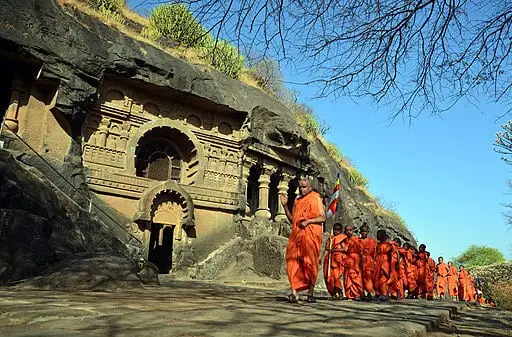Exploring the Enigmatic Trirashmi Buddhist Caves
Tucked away amidst the lush hills of Western India, lies a hidden treasure that dates back over two thousand years. The Trirashmi Buddhist Caves, also known as the Trirashmi Leni Caves or the Karla Caves, have long intrigued archaeologists, historians, and spiritual seekers alike. This magnificent collection of rock-cut caves offers a unique window into the spiritual practices and beliefs of ancient India.
Uncovering the Mysterious Trirashmi Buddhist Caves: Unveiling Ancient Mysteries
The Trirashmi Buddhist Caves are believed to have been carved out between the 2nd century BCE and the 2nd century CE, during the reign of the Satavahana dynasty. Carved into a massive hill, these caves are a combination of Chaitya halls (prayer halls) and Viharas (monasteries). The most renowned of these caves is Cave 7, also known as the Karla Cave. Its grand entrance, adorned with intricately carved pillars and sculptures, immediately captures the imagination.
Step inside Cave 7, and you’ll be transported to a different era. The grand Chaitya hall, with its high vaulted ceilings and beautiful stupa, creates an awe-inspiring atmosphere. The walls of the cave are adorned with sculptures depicting scenes from the life of Buddha and various Bodhisattvas. The level of detail and craftsmanship displayed in these sculptures is truly remarkable, making one wonder about the skilled artisans who brought these carvings to life.
Aside from Cave 7, the Trirashmi Buddhist Caves consist of a total of 36 more caves, each with its own unique charm. Some caves were used as dwelling spaces for monks, while others served as meditation halls. The architecture and layout of these caves provide valuable insights into the communal and spiritual lives of the ancient Buddhist community that inhabited them.
Delving into the Depths of Trirashmi Buddhist Caves: Unearthing Spiritual Secrets
As you venture deeper into the Trirashmi Buddhist Caves, you’ll discover a sense of tranquility and serenity that is often associated with spiritual spaces. The dimly lit interiors, the smell of incense lingering in the air, and the sound of chanting create an ambiance that encourages introspection and contemplation. It’s easy to imagine the monks of the past engaging in deep meditation and philosophical discussions within these very walls.
One of the most fascinating aspects of the Trirashmi Buddhist Caves is the presence of intricate rock-cut chaityas. These prayer halls were designed to resemble wooden structures, complete with wooden beams and rafters, even though they were entirely carved out of rock. The attention to detail in replicating wooden architecture within the constraints of stone is a testament to the skill and ingenuity of the ancient craftsmen.
The caves also feature numerous inscriptions, providing valuable historical and cultural information. These inscriptions, written in Brahmi script, reveal the names of the donors who contributed to the construction and maintenance of the caves. They shed light on the patronage and support extended to the Buddhist community by rulers and wealthy individuals of that time.
As you emerge from the depths of the Trirashmi Buddhist Caves, it’s hard not to be filled with a sense of wonder and reverence for the ancient wisdom and spirituality that thrived within their walls. These caves stand as a testament to the enduring legacy of Buddhism in India and the profound impact it had on the lives of countless individuals over the centuries.
The Trirashmi Buddhist Caves are more than just archaeological wonders; they are portals into a world long gone, offering us a glimpse into the spiritual practices and beliefs of our ancestors. These caves remind us of the importance of preserving and cherishing our heritage, and they serve as a source of inspiration for those seeking solace and enlightenment today. Whether you are an archaeology enthusiast, a history buff, or a spiritual seeker, a visit to the Trirashmi Buddhist Caves is sure to leave you with a deep sense of awe and reverence for the ancient wisdom that they embody.
Image credit
Prashant Kharote, CC BY-SA 4.0, via Wikimedia Commons
